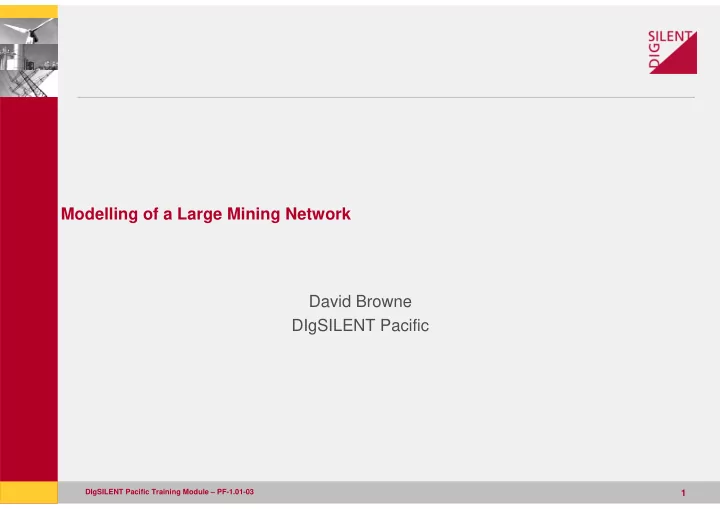

Modelling of a Large Mining Network David Browne DIgSILENT Pacific DIgSILENT Pacific Training Module – PF-1.01-03 1
Background • Large mine development in North-West of W.A • 500MW on-site power plant (not grid connected) – Gas Turbines – Steam Turbines (Heat Recovery Steam Turbine) • Network consisting of 220kV, 33kV, 11kV, 6.6kV and 415V • Loads – 15MW Ball Mill – 28MW AG Mill (Cyclo-converter) DIgSILENT User’s Conference 2
DIgSILENT Pacific Training Module – PF-1.01-03 3
Motivation • Islanded industrial networks present many unique challenges • Finding the right solution(s) requires a good understanding of the problem • In-depth analysis can be achieved with powerful computer simulation packages; – Load flow/short circuit – Dynamics (voltage frequency) – Power Quality (harmonics, flicker) – Transients – Protection 4
Problems in Large Industrial Networks Classification Risks Cause Control Measures Frequency instability Cascading Loss of Generation Load Shedding • • tripping of; • Tripping of large • Adequate control of • Load: motors of VSDs generator reserves motors, • Adequately tuned VSDs frequency control system • Generation Voltage instability Loss of load • Motor Dynamics • Reactive Compensation (start-up) (dynamic/static) • Voltage control schemes Harmonic distortion Thermal VVVF drives Passive/Active harmonic • • • stress Resonance filters • Control 12, 18 pulse front end • • problems converter VVVF drives Protection Spurious Poor/incorrect Appropriate setting of • • • tripping setting of protection devices Long protection relays • tripping times 5
Benefits of Computer Simulations Solution Type of Simulation Outcomes Load shedding Dynamic (Frequency) Optimised setting of U/F, ROCOF load shedding elements Frequency control Dynamic (Frequency) Tuning of frequency controllers/governors Reactive Compensation -Dynamic (voltage) Optimised sizing and placement of capacitor -Load flow banks, SVCs Harmonic Filters Harmonic load flow, Appropriate specification of harmonic filter • frequency sweep banks Assessment of different options • (Active/Passive) Setting of protection Protection Appropriate setting of protection relays • devices coordination Management of network protection settings • 6
Developing the Network Model • The development of any model requires correct and accurate information. Sources of information for this project included; – Cable schedules (Cable lengths, size, type) – Overhead lines (conductor, geometric arrangement) – Transformer datasheets/nameplate (rating, vector group, impedance) – Load lists – Single Line Diagrams (CT ratios, VTs) – Generator datasheets (impedances, time constants) – Motor datasheets – Protection (relay models and settings) – Manufacturer AVR and governor control block diagrams – Power station control philosophy (frequency, voltage control) • Due to the large size of the network, careful control and management of information sources was critical in ensuring an accurate model 7
Dynamic Models Generation • Governors • AVRs and exciters • Secondary frequency and voltage controllers • Automatic tap changing controllers Load • Ball Mill • Variable speed drives • Direct On-Line (DOL) drives 8
Power Station Frequency Controller �� � � � � 1 ��� ���� � � � � ∗ ��� 9
Power Station Frequency Controller DIgSILENT Pacific Training Module – PF-1.01-03 10
Power Station Voltage Controller DIgSILENT Pacific Training Module – PF-1.01-03 11
Ball Mill Motor Model 12
Variable Speed Drive Model • Dynamic loads using the PowerFactory *ElmLod element has been used to model the VSDs � � � � � ∗ � � � � � � � = � ∗ � � � � • Exponents have been set to 0 to represent a constant power load • Large VSDs and the cyclo- converter have been modelled with a user defined PQ starting characteristic to represent the actual starting characteristic as measured on site 13
Variable Speed Drive Model • VSD controllers have voltage and frequency set-points that disconnect the drive on a voltage/freq event 14
Protection Model • Total of 600 protection relays associated with the HV distribution system • 25 different relay models/type • DPL scripting enabled protection relay settings to be managed in an excel spread sheet and imported into the respective PowerFactory relay model • Protection elements models included; – Direction and non-directional over-current/earth fault – Differential, Restricted Earth Fault – Frequency (U/F, O/F), Voltage (U/V,O/V, negative phase sequence) – Motor protection (Thermal overload) 15
Model Validation • Accuracy of dynamic models needs to be confirmed against actual site test measurements • Parameters from manufacturers, or typical parameters, do not always accurately represent the true performance of the system • Models that require validation include; – Exciter – Governor – Automatic voltage regulator – Power station controllers (voltage, frequency) – Ball Mill start-up characteristic (ramp time, peak inrush current) – Cyclo-converter start-up characteristic (Active/reactive power) • Models are verified by undertaking a series of site tests (generator voltage/frequency step, motor start-up) and simulating the same test in the PowerFactory model 16
Model Validation Generator unsynchronised voltage step test Original Exciter Model Parameters Revised Exciter Model Parameters 17
Conclusion • A power system model has been developed for a large mine that can facilitate the following types of studies; – Load flow: Equipment loading, voltage regulation – Short-circuit: Equipment fault ratings – Dynamic simulations: Start-up of Mills/large motors, frequency and voltage stability following loss of generation or load – Protection coordination: Grading of over-current and earth fault protection elements • The dynamic performance of the generators and the loads models have been verified against site tests (ongoing process) • The model will serve as a useful tool for; – Future planning – Diagnosing problems before they occur DIgSILENT Pacific Training Module – PF-1.01-03 18
Recommend
More recommend